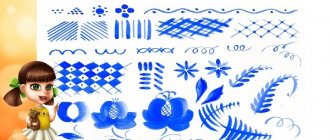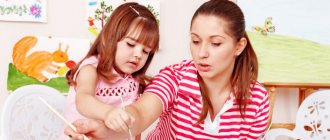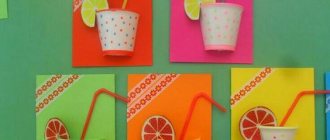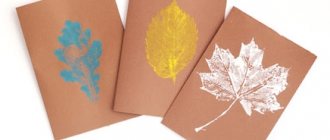Evgenia Kirichenko
Notes on drawing in the preparatory group “Dishes for Fedora. Tea-set"
]Summary of GCD for drawing in the preparatory group
“ Dishes for Fedora . Tea-set "
.
Goal: to create conditions for the development of children’s skills in drawing from life, observing proportions, placing the drawing over the entire sheet of paper.
Tasks:
— activate children’s vocabulary on the topic “ Dishes ”
;
- consolidate the use of nouns in diminutive form;
- develop the ability to independently compose a composition;
- develop technical skills - skillfully use a brush ( paint with the tip of the brush , holding it in a vertical direction, with the whole brush, move freely in different directions).
Material and equipment:
multimedia, book by K. I. Chukovsky “ Fedorino’s grief ”
, ball,
teapot and cup , Su-Jok springs, cut pictures, gouache, brushes, water jars, napkins, album sheets.
Preparatory stage
A distinctive feature of children 3–4 years old is increased restlessness and activity. Therefore, when preparing a lesson, the teacher must carefully consider the organizational aspects of the work so that every minute is in activity, but there is no monotony. In general, there are no trifles in preparation.
What colors and base should I choose?
Many kindergarten teachers working in senior and preparatory groups note that many children are reluctant to take up drawing. And this is due to the fact that at a younger age, when the little ones were just beginning to get acquainted with visual arts, the wrong materials were used. Namely pencils or watercolors. The fact is that even experienced artists consider watercolor to be a very difficult material, and it is not at all suitable for first artistic experiments.
Nevertheless, reasonable price and availability make watercolor the most popular material for drawing in kindergartens.
Gouache is considered the most convenient material for children's creativity.
As for pencils, in classes in the middle group (and in the junior group too) you can use only soft leads. If we talk about the recommended types of visual materials, then these are gouache and wax crayons - with their help, kids don’t have to put in a lot of effort to get a picture, they “draw on their own.” Separately, it is worth mentioning the use of felt-tip pens. They are used only for outlining and drawing accents of the pattern (for example, when creating a plate design). But they are not used for coloring.
This is interesting. Many methodologists prohibit the use of felt-tip pens in kindergartens, citing the fact that with their help it is impossible to explain to little artists the possibilities of full color rendition of shades, as well as to create elementary shadows.
As a base, it is better to use regular printer paper or thin cardboard in A4 or ½ A4 format (if the composition is a group one, placed on a common backing).
What techniques and techniques can be used?
At 3–4 years old, children can trace with a pencil ready-made stencils of simple shapes (that is, without small details), as well as make simple sketches of geometric shapes from life.
Unlike non-traditional techniques, traditional ones give a more complete idea of the shading capabilities of the palette
From this we can conclude that both traditional and non-traditional drawing techniques can be used for classes. However, it is the traditional ones that provide the opportunity to comprehensively develop fine motor skills, as well as cultivate a sense of color. Classic techniques suitable for the average group are
- coloring template pictures;
- adding details to the finished image (for example, children add a pattern to the finished drawing of a plate);
- tracing and coloring the stencil;
- drawing simple shapes from life.
This is interesting. Experienced methodologists believe that drawing from life can only begin when children have already mastered tracing and painting stencils well.
If we talk about techniques, then in the middle group they rely on the fact that the limiters of the image are the points of the depicted object, and not the edges of the sheet. Thus, the following techniques can be used:
- painting small and large parts of the image;
- drawing thick lines with an inclined position of the brush, resting on the entire pile;
- drawing thin lines with the brush in a vertical position, touching the paper with only the tip of the bristles;
- working with shades, in particular, obtaining the desired color through classic combinations (for example, white and red for pink);
- painting an image with the pencil in an inclined position relative to the sheet.
Photo gallery of drawings on the theme “Dishes” using non-traditional techniques
For the base of the stamps, you can use ordinary cotton pads. For coloring using the poking technique, you can use cotton swabs or brushes. The finger painting technique allows you to paint dishes with contents so that they seem voluminous. Pokes in one drawing can be of different colors.
Additional types of visual activities
The task of the aesthetic development of children in kindergarten is to give an idea of different types of visual activities. But since children show varying degrees of interest in drawing, appliqué, modeling, etc., the implementation of the task is facilitated by a combination of creative methods. Drawing can be called a universal type of work, as it combines perfectly with other types of fine art. Thus, brushes and pencils can be “made friends” with
- natural material (for example, in the form of fruits and vegetables on a plate);
- pieces of fabric (for finishing cups and saucers);
- plasticine (both as decoration for dishes and to imitate the contents);
- colored paper.
This is interesting. It is important for a teacher who involves additional types of visual activities to remember that they are “additional”, that is, they should not be assigned a role greater than that required by the task of decorating dishes.
How to personalize a task?
At all stages of educational activity, the teacher must find ways to implement an individual approach. Finding them in kindergarten, on the one hand, is not easy, since all toddlers are at approximately the same level of development. But on the other hand, children have not mastered many skills, so their range of interests is not very wide. In a drawing lesson on the topic “Dishes”, you can individualize the task, leaving it to the little artists
- choosing a color scheme for the picture;
- background of the substrate (especially if colored sheets of paper or cardboard are used as the basis);
- additional ways to decorate the drawing (with pieces of plasticine or colored paper confetti).
After a detailed explanation of the task, the teacher gives the children maximum creative freedom
Individualization makes children feel like adults and independent. So a simple task to prepare the necessary materials for work, laying everything out near your work places can play along with this.
The place of the topic in calendar and thematic planning
The topic “Utensils” in the middle group is studied in different interpretations. So, when studying the fairy tale about Pinocchio, children draw Malvina’s favorite cup, and after discussing household items that are in every home, they sketch plates and tea pairs. The teaching staff of an individual kindergarten determines the topics of classes depending on the place given to drawing in the context of other classes. If we talk about a generalized version, then the wording may sound like this
- “Little Bear’s Cup” (when studying the fairy tale “The Three Bears”);
- “Treats for the doll” (children draw the fruits or vegetables they have studied on a plate);
- “My mom’s favorite cup” (for example, as a card for mom for Mother’s Day or for March 8);
- “What does the pattern on the plate tell you?” (after getting acquainted with the country's folk crafts);
- “Cup and saucer for a doll” (a universal topic, since it can be used after repeating simple geometric shapes, and in the context of talking about household items that we cannot do without);
- “Tea party with friends” (an option for group work, when children draw cups, and then the finished drawings are hung on a common background - the dining table);
- “Runaway Dishes” (when studying Korney Chukovsky’s fairy tale “Fedorino’s Grief”), etc.
Summary of GCD for drawing “Teaware”
Natalia Shamina
Summary of GCD for drawing “Teaware”
Abstract of GCD for Drawing . Educational field "Art. aesthetic development"
Topic:
“
Teaware ” Goal: Improve the ability to draw with pokes , trying to evenly arrange (peas)
inside the outline.
Objectives: Educational area “Cognitive development”
1. Continue to form an idea of color.
2. Develop imagination, attention, memory.
Educational field "Speech development"
1. Activate adjectives in children’s speech (red, round)
2. Finish words and phrases.
Educational field "Artistic and aesthetic development"
1. Cultivate children's interest in the drawing .
Educational field "Social and communicative development"
1. Perception of fiction.
2. Cultivate accuracy and independence.
Educational field "Physical development"
1. Master the basic norms and rules of safe behavior.
2. Develop fine motor skills of the hands.
Preliminary work: reading K. Chukovsky’s fairy tale “Fedorino’s grief”
, examination of illustrations on the topic
“
Teaware ” , role-playing game
“Tea Party”
, finger gymnastics.
Equipment and materials: Demonstration material - pictures depicting dishes with patterns ( white tea cup )
;
Toy bi-ba-bo Grandma. Liquid gouache paint (red and blue)
; cotton swabs, wet wipes, easel, templates
of tea cups according to the number of children. A teacher's sample of a decorated tea cup .
How to motivate children?
We found out that children, due to their age, enjoy the process of drawing. But for a successful lesson, the teacher needs to choose a combination of techniques that would properly set up the little ones for work. Please note that this should not be one, but a set of techniques.
Conversation and visibility
In the list of motivational techniques, this pair will occupy a leading position, since at 3–4 years old, visual-figurative thinking is the leading one for children, that is, they must see or clearly imagine what is being discussed. So pictures, photos, real dishes - this is the set that should be before the eyes of little creators.
Visualization must be accompanied by a detailed explanation
Any demonstration is accompanied by a story from an adult and a conversation about what was heard - this is an axiom of the method of working with children. The following set of questions can be suggested on the topic:
- “What does it mean to be a hospitable host?”;
- “What is tea party?”;
- “What are the dishes for?” (as an option - individual items of kitchen utensils);
- “Do you (your family members) have a favorite cup?”;
- “Why did the dishes escape from Fedora?” etc.
Poems
Children love to listen and recite poems. For motivation, you can invite the kids to tell or listen to an excerpt from Chukovsky’s poetic fairy tale “Fedorino’s Grief,” as well as a whole series of funny rhymes.
Table. Examples of poems about dishes
Puzzles
Guessing riddles has one undeniable advantage compared to other motivational techniques - children immediately get involved in the work because of the excitement of guessing what is encrypted in it.
- Granny cooks soup for us in it. There is ... (saucepan) on the table.
- It is necessary for us, because we eat food from it. Deep and shallow they call it... (a plate).
- On the stove is the boss of the pots. Thick, long-nosed...(teapot).
- I puff, puff, I don’t want to get warm anymore. The lid rang loudly: Drink tea, the water has boiled! (kettle).
Children can, when solving riddles, not only name, but also show the encrypted object
Fairy tales
There are no less fans of listening to fairy tales in children's groups than there are fans of poems and riddles. In addition to the already mentioned fairy tales “Fedorino Woe”, “Pinocchio”, “Three Bears”, children can be asked to work through (listen to, answer questions, draw the main character) the following stories:
- Once upon a time there was a teapot. He had a family of dishes. The teapot was pot-bellied. It had a handle, a lid and a small spout with one nostril. The kettle was iron and very useful. People loved it and drank tea from it.
- I am a large enamel pan. I am blue. My insides are all white. And brilliant. I'm very proud of it. I help people prepare soups and main courses, and people love me for this.
GCD move:
Educator: Hello, guys! Look who came to us today!
This is Fedor's grandmother! Let's say hello to her!
Grandmother Fedora knows a lot of nursery rhymes, which she has already shared with us, and today she came to tell her favorite nursery rhyme.
"Okay"
. Let us listen to it carefully.
Grandmother baked us sweet pancakes, poured butter on us, and gave it to the children.
- I gave it to everyone! I gave it to everyone!
-Who did grandma bake pancakes for? (children's answers)
— What did Grandma water them with (children’s answers)
Educator: It’s time to give our guest some tea.
What do they drink tea from? (children's answers)
. That's right, from mugs.
Look, we only have one mug. And how beautiful she is. Do you want the same one? (Children's answers)
But before we start
drawing , let's stretch our fingers.
Scheme for drawing up lesson notes
In order for the children to be organized and the teacher to be able to achieve their goals, the lesson time must be clearly distributed between all stages of work on the topic. And a well-structured lesson summary plays a significant role in achieving this. It is necessary to begin work on its preparation by formulating goals. The options may be the following:
- consolidation of knowledge about dishes;
- development of artistic and aesthetic taste;
- developing the ability to work with paints and brushes, pencils, etc.;
- training the eye and spatial orientation on a sheet of paper;
- work on speech development;
- education of emotional responsiveness;
- developing the ability to reflect on the results of one’s work and the work of one’s comrades.
The objectives of the lesson will differ depending on the topic, but in general the wording could be as follows:
- to form children’s ideas about the purpose of dishes;
- expand vocabulary on the topic (cup, saucer, plate, spoon, etc.);
- teach to convey the image of a drawing using simple geometric shapes;
- develop observation skills;
- cultivate initiative in verbal communication with friends and adults;
- cultivate a patient attitude towards the creative process.
The next level of preparation is the distribution of time (standard 30 minutes) for all stages of the lesson.
Example of a summary
Ismailova Yulia “Synopsis on visual activities in the middle group. Topic: dishes, drawing a cup and saucer"
| Yes, that's right guys, look on your table, everyone also has a painted cup and saucer, but it needs to be painted so that it is beautiful, the same as mine. See how I do this first. I wet the brush in a glass of water, leave the excess water on a napkin, then dip the brush in paint, take just a little paint onto the brush, and start painting my cup. First I will paint the saucer without going to the mug, then I will color the handle of the cup, and then I will decorate my cup with mugs. My cup is ready. Now start coloring the cup, first the saucer, then the handle, and then the cup itself. (I walk through the rows and look who needs help). Final part. At the end of the lesson, I sum it up, saying that everyone’s cups turned out beautiful, and after they dry, we’ll see who got what kind of cups and saucers. Once again, to reinforce it, clarify what type of dishes the cup and saucer belongs to.> |
GCD for drawing in the senior group. Online broadcast “Tea service”
Irina Kozaeva
GCD for drawing in the senior group. Online broadcast “Tea service”
test and consolidate knowledge and ability to independently name Gzhel painting and elements of its patterns, conveying its characteristic features;
Tasks:
— Expand and consolidate children’s ideas about Gzhel painting.
— Continue to introduce children to the art of Gzhel masters.
-Learn to make an ornament using the element “droplet”, “dot”, “wave-border” using a thin brush, cotton swabs, be able to apply fine brush strokes on paper (blanks from album sheets).
Strengthen the drawing techniques with the end of the brush, all the bristles, and dabbing.
-Develop children's interest in folk arts and crafts, promote the development of aesthetic taste.
— Develop imagination, thinking, speech and fine motor skills of children’s hands.
To foster a sense of pride in the talent of the Russian people, to cultivate interest in folk arts and crafts and the desire to create decorative objects with one’s own hands - the Gzhel service.
Dishes (teapot, cups, etc., made using the Gzhel technique, cut-out teapot blanks from landscape paper, blue gouache, brushes, cotton swabs, napkins.
Preliminary work
: display of illustrations, postcards on the theme: “Gzhel”, use of ICT, slide presentation, board and printed games.
Progress of educational activities:
1. Problem situation.
The girl Gzhelka comes and says:
— When I was in the meadow with my friends Gorodeshka and Khokhlomushka, we were picking flowers. But the wind blew and tore all the petals from the flowers. The petals are mixed... Help me collect my flower!
— To find out how to help us and what we will do, guess the riddle.
Porcelain teapots, candlesticks, clocks
Animals and birds of unprecedented beauty
A village in the Moscow region has now become famous
Its name is known to everyone...
Stages of working on a drawing
“A pair of tea - a plate and a cup - for mom”
For this drawing you will need paints and markers. The basis of the picture is cut out templates. The task can be either individual or collective, for example, creating a set for mothers.
When doing this drawing, children learn to paint the background evenly
Instructions
- The teacher gives the children cut out cup and saucer templates.
- “Make a background with paints on the pair.”
- While the background dries, children perform finger exercises or physical education.
- “Now use felt-tip pens to draw the outline of the dishes and complete the pattern.”
- “Please note that the pattern must be the same and positioned symmetrically.”
This is interesting. As a way to individualize the task, children with confident visual skills can draw decor in the form of berries, fruits (for example, cherries, apples), and those who are not too strong in drawing can draw zigzag lines, dots, etc.








